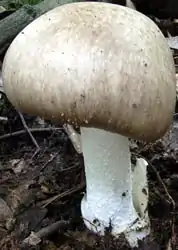| Amanita manginiana | |
|---|---|
 | |
| Scientific classification | |
| Domain: | Eukaryota |
| Kingdom: | Fungi |
| Division: | Basidiomycota |
| Class: | Agaricomycetes |
| Order: | Agaricales |
| Family: | Amanitaceae |
| Genus: | Amanita |
| Species: | A. manginiana |
| Binomial name | |
| Amanita manginiana Har. & Pat. | |
| Amanita manginiana | |
|---|---|
| Gills on hymenium | |
| Cap is umbonate | |
| Hymenium is free | |
| Stipe has a volva | |
| Spore print is white | |
| Ecology is mycorrhizal | |
| Edibility is not recommended | |
Amanita manginiana, also known as Mangin's false death cap, Chiu's false death cap, is a species of the genus Amanita.
Description
The cap of Amanita manginiana is around 5–8 centimetres (2–3 inches) wide, chestnut brown, darker in the center, with the margin more pallid, silky (bearing fine hairs), convex then applanate, fleshy, and has a nonstriate margin. The gills are adnate and white. Short gills are present. The stipe is around 5–8 cm high, cylindrical, stuffed, white, becoming orangish-brown. The bulb is fleshy, globose to ovoid. The ring is membranous, white, superior, skirt-like. The volva is membranous, limbate, and fulvous-white. The spores measure 7–8 × 6 µm and are ovoid to subglobose. Its spores have a length of around 9.2–10.3 µm and a width of 7.5–7.8 µm. The spores are nothing but amyloid rubble and the collected specimens are unfortunately, almost entirely useless.[1]
This species is very poorly known. Sources state a species similar to A. manginiana from China under the name A. manginiana sensu W.F. Chiu.
Edibility
A. manginiana appears to belong with a group of edible species that at the moment are classed in Amanita section Phalloideae, but the edibility of A. manginiana is unknown.[1]
According to China Forestry Culture Collection Center, it is reported to be edible with potential medical use.[2] However, due to its similarity to lethal species, consumption is unadvisable.[3]
See also
References
As of this edit, this article uses content from "Amanita manginiana", which is licensed in a way that permits reuse under the Creative Commons Attribution-ShareAlike 3.0 Unported License, but not under the GFDL. All relevant terms must be followed.
- 1 2 "Amanita manginiana". Amanitaceae.org. Retrieved 2016-08-25.
- ↑ "隐花青鹅膏 - China Forestry Culture Collection Center". Archived from the original on 2017-10-17. Retrieved 2017-10-17.
- ↑ 云南野生蘑菇中毒防治手册 2011.05
